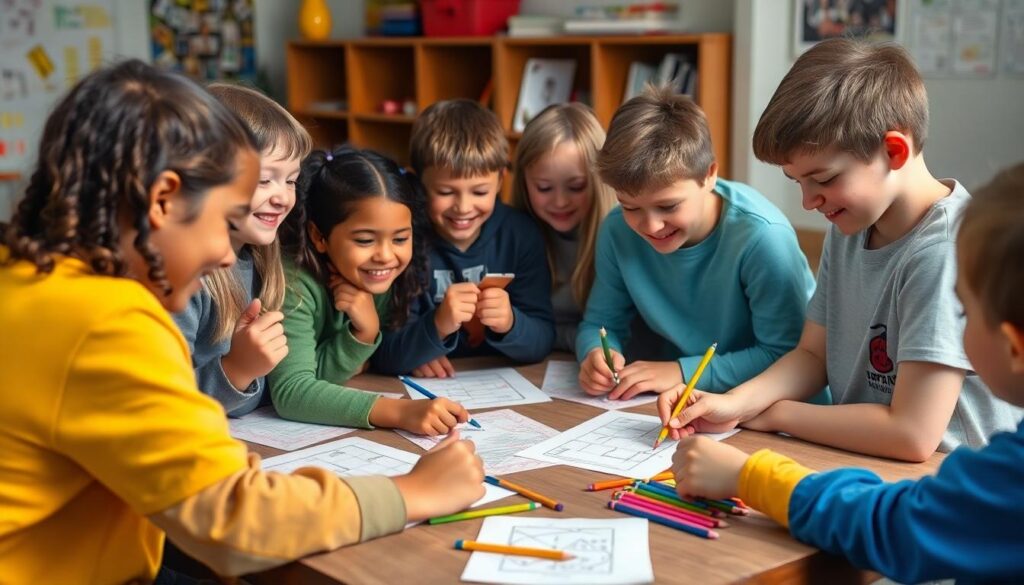Looking for the perfect brain teasers for your 5th grader? We’ve gathered an entertaining collection of age-appropriate riddles that will challenge young minds while keeping them engaged and smiling. These carefully selected puzzles strike the ideal balance—complex enough to make kids think critically but still solvable for 10-11 year olds.
In today’s screen-dominated industry, riddles offer a refreshing mental workout that sharpens problem-solving skills and boosts creativity. They’re perfect for classroom activities, family game nights, or anytime your child needs a fun cognitive challenge. Our 5th grade riddles work wonderfully as ice-breakers, time-fillers between lessons, or even as educational entertainment during long car rides.
10 Challenging 5th Grade Riddles to Boost Critical Thinking
- What has keys but no locks, space but no room, and you can enter but not go in?
A keyboard contains many keys yet doesn’t unlock anything physical. It offers space without having actual dimensions of a room. You can enter data on it but can’t physically go inside it.
- I’m light as a feather, but even the strongest person can’t hold me for more than a few minutes. What am I?
Breath escapes everyone eventually no matter their strength. Even Olympic athletes must eventually exhale their breath. This riddle encourages students to think beyond physical objects.
- The more you take, the more you leave behind. What am I?
Footsteps increase in number with each step taken. Walking creates more footprints as you continue forward. Children must consider actions that leave evidence behind rather than taking objects away.
- What belongs to you but others use it more than you do?
Your name gets spoken by friends, teachers, and family regularly. People call you by it daily in conversations and attendance. Students need to consider personal possessions that function primarily for others.
- I have cities but no houses, forests but no trees, and rivers but no water. What am I?
A map displays geographical features without containing their physical elements. It shows locations symbolically rather than literally. This riddle helps children distinguish between representations and real objects.
- What can travel around the industry while staying in a corner?
A stamp travels on envelopes to distant destinations without moving from its corner position. Mail carrying the stamp reaches places worldwide. This brain teaser requires thinking about objects that help travel without moving themselves.
- What has one eye but cannot see?
A needle contains an eye for threading yet possesses no vision capabilities. Sewing needles feature this distinctive opening at one end. Students must consider multiple meanings of the word “eye” to solve this riddle.
- What gets wetter as it dries?
A towel absorbs moisture when drying objects or people. Its purpose involves becoming wet while making other things dry. This paradoxical riddle challenges students to think about cause and effect relationships.
- I’m tall when I’m young and short when I’m old. What am I?
A candle grows shorter as it burns down over time. New candles stand at their full height before use. Fifth graders must visualize how certain objects change in opposite ways than living things.
- What has a head and a tail but no body?
A coin features heads and tails sides without a middle section. Currency displays these two distinct faces for decisions and value. Solving this requires students to think about objects with descriptive parts that don’t match animal anatomy.
Fun Math Riddles That Will Make Your 5th Grader Think

Mathematical riddles offer a perfect blend of fun and learning for 5th graders, helping them develop critical thinking skills while enjoying the puzzle-solving process.
Number Pattern Puzzlers
- The Three Generations Puzzle: Two fathers and two sons made chairs, but only three chairs were produced. Why? The answer lies in family relationships – there were only three people: a grandfather, his son, and his grandson. Each person is simultaneously fulfilling two roles!
- Division Trick: Ask your 5th grader: “If you divide 30 by ½, then add 5, what’s the result?” Many will answer 15, but the correct answer is 65. When dividing by a fraction, you actually multiply by its reciprocal (30 × 2 = 60), then add 5.
- Upside-Down Math: Write “81 × 9 = 801” and challenge your child to figure out how this equation could be true. The secret? Turn the page upside down and you’ll see: 108 = 6 × 18, which is correct!
- Letter Count Pricing: Present this scenario: “A store prices items based on the number of letters in their name at $5 per letter. How much would a coat cost?” The answer is $20 since “coat” contains 4 letters.
Geometry Brain Teasers
- Circle Sides: How many sides does a circle have? While many 5th graders might say “zero” or “one,” the surprising answer is two – the inside and the outside!
- School Distance Riddle: Two kids leave for school at different times but meet in the school parking lot. Who’s closer to school? The answer is neither – they’re both equally close since they’re at the same location.
- Mathematical Complaints: If two math books started complaining to each other, what would they say? “I have way too many problems!” This wordplay riddle connects language skills with mathematical concepts while giving kids a good laugh.
These math riddles enhance critical thinking by combining logic with arithmetic and spatial reasoning. The three generations puzzle challenges linear assumptions about relationships, while the upside-down equation emphasizes visual problem-solving approaches. Word-based riddles strengthen the vital connection between language and mathematics that’s crucial for academic success.
Word Play Riddles Perfect for Language Arts Enhancement
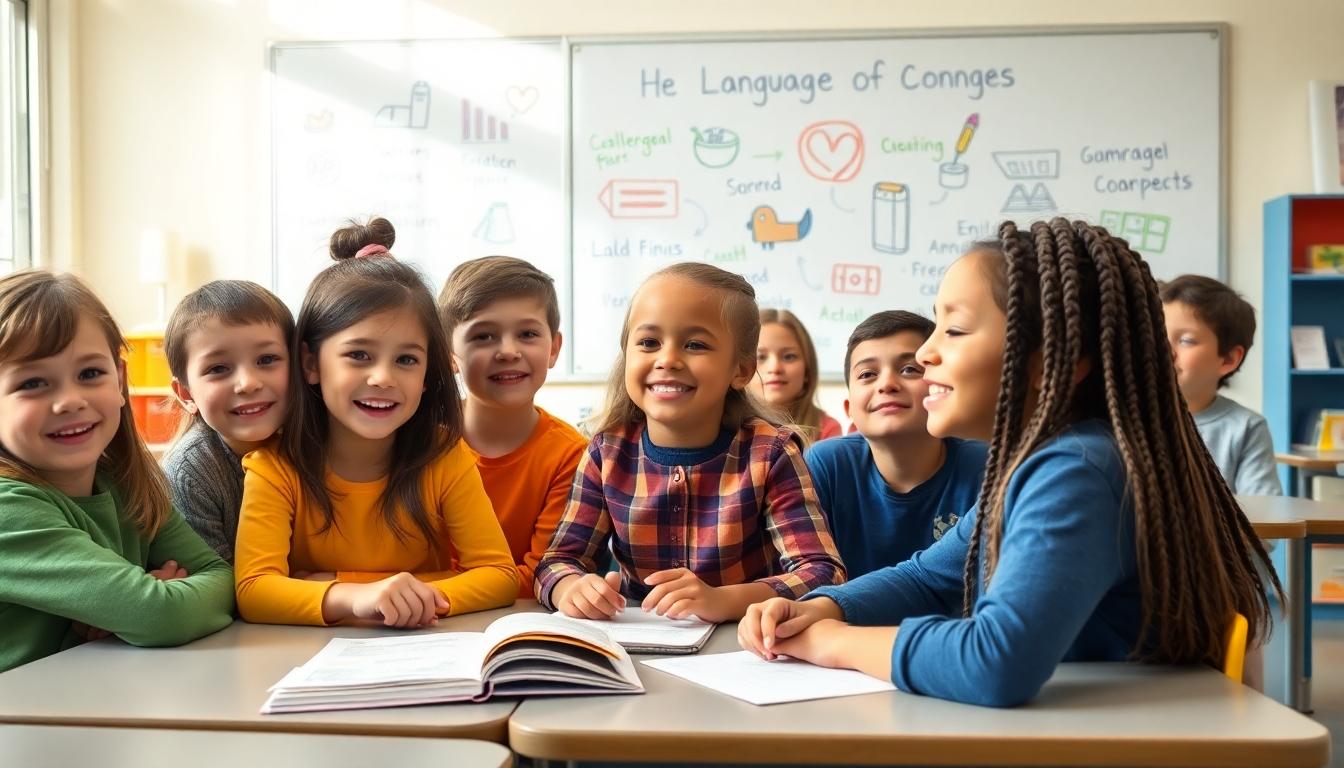
Word play riddles offer excellent opportunities for fifth graders to develop linguistic skills while having fun. These brain teasers focus on homophones, homonyms, and double meanings that challenge students to think beyond literal interpretations of language.
Pun-Based Brain Teasers
Pun-based riddles combine humor with sound-based creativity to engage students in language exploration. “What breaks as soon as you say its name?” (Answer: Silence) encourages children to consider both literal and metaphorical interpretations of words. Students love solving riddles like “What runs all around the backyard but never moves?” where the answer “A fence” plays on multiple meanings of the word “runs.” These clever word twists help fifth graders recognize how a single word can carry different meanings depending on context. Incorporating these brain teasers into language arts lessons creates memorable learning experiences that strengthen students’ understanding of figurative language.
Vocabulary-Building Riddles
Vocabulary-building riddles introduce students to nuanced language expressions while reinforcing critical thinking skills. “What has one eye but can’t see?” (Answer: A needle) helps children understand metaphorical vocabulary and object descriptions. Another effective example is “What can you catch but not throw?” with the answer “A cold” highlighting the dual meanings that common words possess. These riddles expose fifth graders to idiomatic expressions and compound terms like those found in visual puzzles such as “Generation gap.” Teachers often integrate these vocabulary challenges into reading activities to contextualize new words and phrases. Group discussions around these riddles create collaborative learning environments where students can enhance their communication skills while expanding their vocabulary knowledge.
Logic Riddles That Develop Problem-Solving Skills
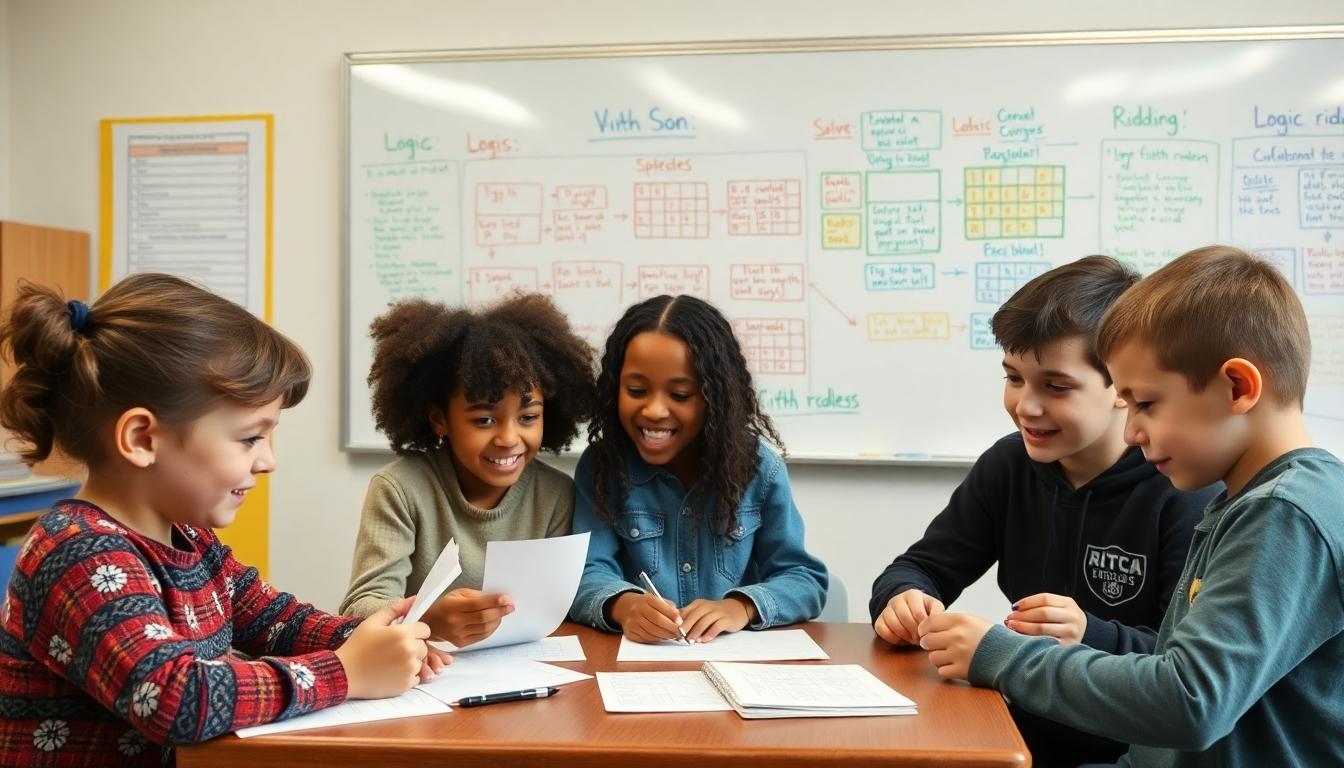
Logic riddles offer fifth graders excellent opportunities to enhance their analytical thinking and reasoning abilities while having fun. These brain teasers require students to apply logical steps and careful reasoning to arrive at answers.
If-Then Puzzles
If-then puzzles challenge students to use deductive reasoning by applying a series of conditions to reach logical conclusions. These riddles help children understand cause and effect relationships while strengthening their ability to follow logical pathways. Consider this example that fifth graders might tackle: “If it is raining, then the streets are wet. If the streets are wet, then you should wear boots. If you should wear boots, then it must be muddy outside. If it is raining, should you wear boots?” Working through these conditional statements helps students develop critical thinking skills they’ll use throughout their academic careers.
Sequencing Challenges
Sequencing challenges require students to arrange items or events in a logical order based on exact clues or conditions. These puzzles are particularly effective at developing organizational thinking and attention to detail. For instance, students might solve a puzzle like: “Arrange five people—Alex, Ben, Chris, David, and Emily—by height, given that Chris is taller than Ben, Emily is shorter than David, and Alex is taller than Emily but shorter than Chris.” Tackling these challenges encourages fifth graders to systematically evaluate multiple conditions simultaneously, creating mental maps of relationships between different elements. Resources like Cuemath and HelloSubs offer many interactive sequencing puzzles specifically designed to enhance cognitive abilities in elementary students.
Science-Themed Riddles for Curious 5th Graders
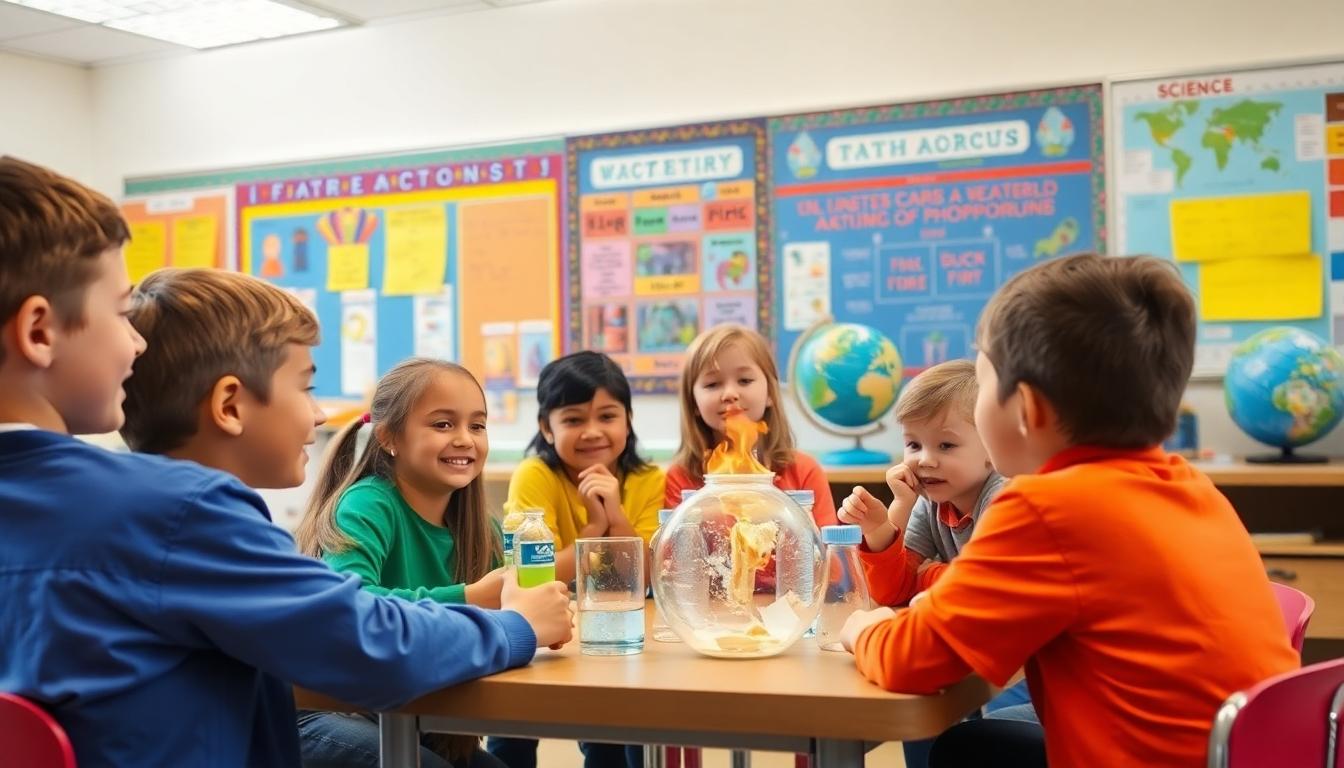
Science riddles offer the perfect blend of education and entertainment for 5th graders, sparking curiosity about the natural industry while developing critical thinking skills.
- I change shape but never disappear. I can be solid, liquid, or gas, and I’m found everywhere. What am I?
Water is the answer to this clever riddle. It’s one of the few substances that naturally exists in all three states of matter on Earth and truly is found almost everywhere, making it an excellent introduction to basic chemistry concepts.
- I’m not alive, but I can grow. I don’t have lungs, but I need air. I’m not a plant, but I need water. What am I?
Fire solves this puzzling contradiction. The riddle helps students understand that fire isn’t technically alive yet exhibits life-like qualities, requiring oxygen to burn and sometimes using water as fuel in exact chemical reactions.
- I live in the sky but fall to the ground. I’m cold and white and make no sound. What am I?
Snow is the silent answer. This riddle introduces students to precipitation and the water cycle, reinforcing science curriculum topics about weather patterns and seasonal changes.
- What element helps you shine in the dark?
Phosphorus answers this glowing question. This riddle introduces students to chemical elements and the fascinating property of phosphorescence, connecting to both chemistry and physics concepts.
- I am a gas that is essential for plants, but I can’t be bought at the gas station. What am I?
Carbon dioxide solves this plant-friendly puzzle. The riddle highlights the importance of this gas in photosynthesis, helping students connect respiration, plant biology, and environmental science.
Animal and Nature Riddles
- I have a tail, whiskers, and purr. What am I?
A cat is the purr-fect answer to this simple yet effective animal riddle. These familiar descriptors help younger 5th graders build confidence in their problem-solving abilities while reinforcing animal classification.
- I have a mane and roar loudly. What am I?
A lion rules as the answer to this riddle. Students practice identifying distinctive animal characteristics while learning about apex predators, habitats, and adaptation.
- I live in the ocean, have a shell, and am slow. What am I?
A turtle crawls into position as the answer. This riddle encourages students to think about marine life, reptiles, and the distinctive physical features that help scientists classify animals.
Simple Physics Puzzlers
- What is heavier: a ton of feathers or a ton of rocks?
They are the same weight! This classic trick question introduces students to the concept that mass is independent of material, laying groundwork for more complex physics concepts like density and volume.
- You can put your eye to this, you can see far. It helps you spot planets, the moon, and even stars. What is it?
A telescope is the stargazing solution. This riddle connects to astronomy units while introducing the physics of optics, helping students understand how lenses and mirrors work together to magnify distant objects.
How to Use 5th Grade Riddles in the Classroom

Incorporating riddles into your 5th grade classroom creates an captivating environment that stimulates critical thinking while making learning fun. These brain teasers serve as perfect tools to develop problem-solving skills and spark creativity in your students.
Educational Games with Riddles
Riddle Relay transforms ordinary lessons into exciting competitions where teams race to solve puzzles like “What begins with T, ends with T, and has T in it?” (Teapot). Students love the challenge of tackling deductive reasoning problems such as the three light switches puzzle within time limits. Riddle Bingo offers another interactive approach where students receive cards featuring answers like “cloud,” “echo,” and “glove,” then mark spaces as you read corresponding riddles aloud. Digital platforms provide additional opportunities for gamified riddle experiences, with resources available through interactive tools like Prodigy or teacher-created materials from online educational marketplaces. These game formats turn ordinary lesson time into memorable learning experiences that students eagerly anticipate.
Creating Riddle-Based Learning Stations
Logic Stations feature lateral-thinking challenges such as “I speak without a mouth” (Echo) paired with guided problem-solving worksheets that help students develop systematic approaches to complex problems. Vocabulary Stations focus on wordplay riddles like “One word spelled wrong in the dictionary” (W-R-O-N-G) to reinforce spelling patterns and expand students’ word knowledge. Collaboration Stations use multi-step riddles including “What is a bunny’s favorite music?” (Hip hop) that require students to discuss and share ideas, improving their communication skills. Creative Writing Stations encourage students to create original riddles using templates from educational resources, strengthening their understanding of language structure and metaphor. Regular rotation of these stations keeps engagement levels high while addressing different learning styles and curriculum objectives. Students benefit most when riddles align with exact lesson goals and progressively increase in difficulty as their skills develop.
Printable 5th Grade Riddles for Home and School
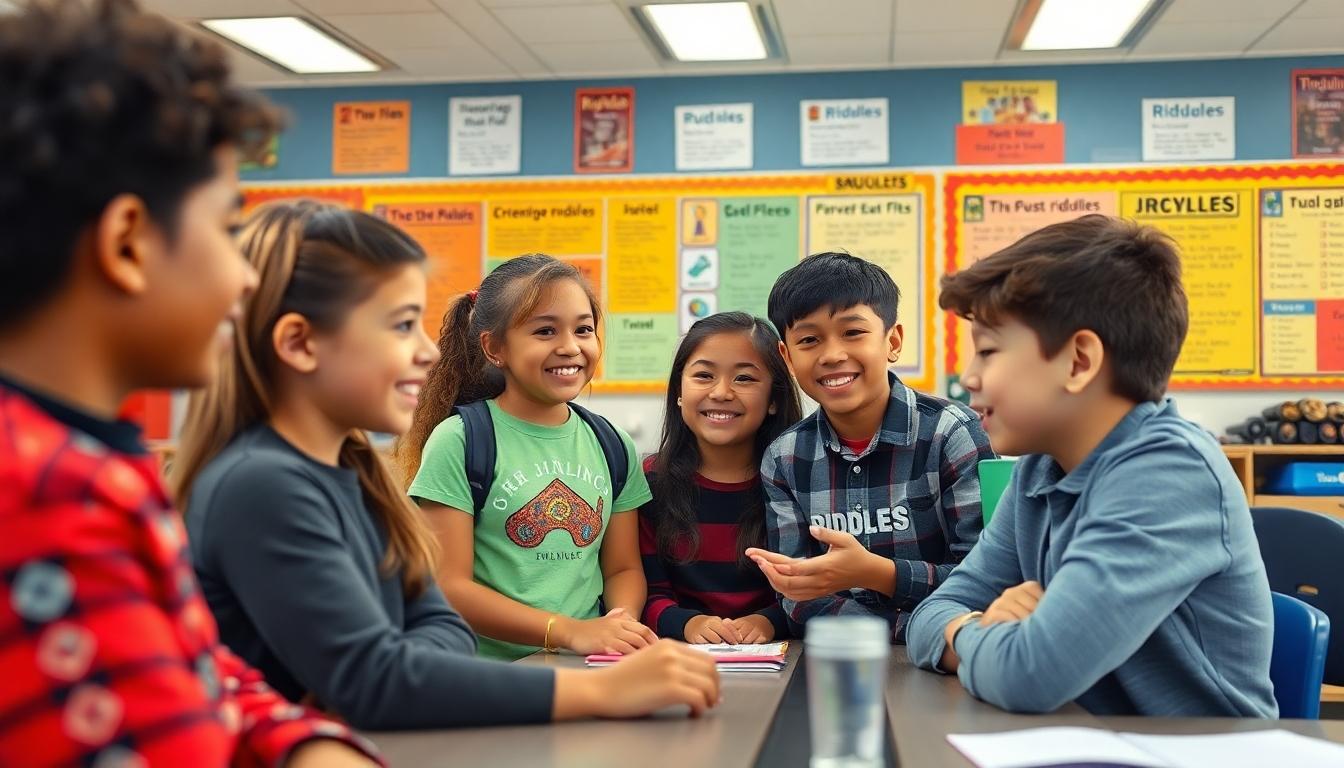
Fifth grade riddles offer excellent opportunities for improving problem-solving skills and creative thinking in students. We’ve compiled a collection of printable riddles that work perfectly in both classroom and home environments, providing educational entertainment that keeps young minds engaged.
Examples of Riddles
- What has keys but can’t open locks?
A piano serves as the answer to this classic riddle that encourages children to think beyond literal interpretations.
- What has a face and two hands but no arms or legs?
A clock is the solution, teaching kids to consider objects from different perspectives.
- What has a neck but no head?
A bottle fits this description perfectly, helping students understand figurative language.
- What gets wetter as it dries?
A towel presents a seemingly contradictory concept that exercises critical thinking.
- What goes up but never comes down?
Your age continues to increase, never decreasing, making this a thought-provoking riddle for 5th graders.
- What has one eye but can’t see?
A needle features an “eye” for thread but lacks vision, introducing children to homonyms.
- What has a head and a tail, is brown, and has no legs?
A penny describes this common coin, teaching students to visualize objects based on descriptions.
- What has an end but no beginning, a home but no family, and a space without a room?
A keyboard contains these seemingly contradictory elements, challenging students to think abstractly.
- How many months of the year have 28 days?
All 12 months have at least 28 days, making this a clever trick question that tests careful thinking.
Resources for Printable Riddles
Several websites offer free printable riddle collections specifically designed for elementary students. Brainzilla provides downloadable riddles in PDF format that teachers and parents can use either online or print for offline activities. ABCmouse features an extensive collection of 300 fun and challenging riddles categorized by difficulty level, from easy to tricky options that suit various learning stages.
ESL Vault stands out for its worksheets that include picture clues alongside riddles, making them particularly helpful for visual learners or students developing language skills. Frugal Fun 4 Boys offers a comprehensive list of 75 riddles and brain teasers that can be printed for use in classroom activities or as entertainment during family game nights.
These printable resources make it simple to incorporate riddles into daily learning routines, whether as morning warm-up activities, transition exercises between lessons, or take-home challenges that encourage family participation in educational fun.
Benefits of Solving Riddles for 5th Grade Development
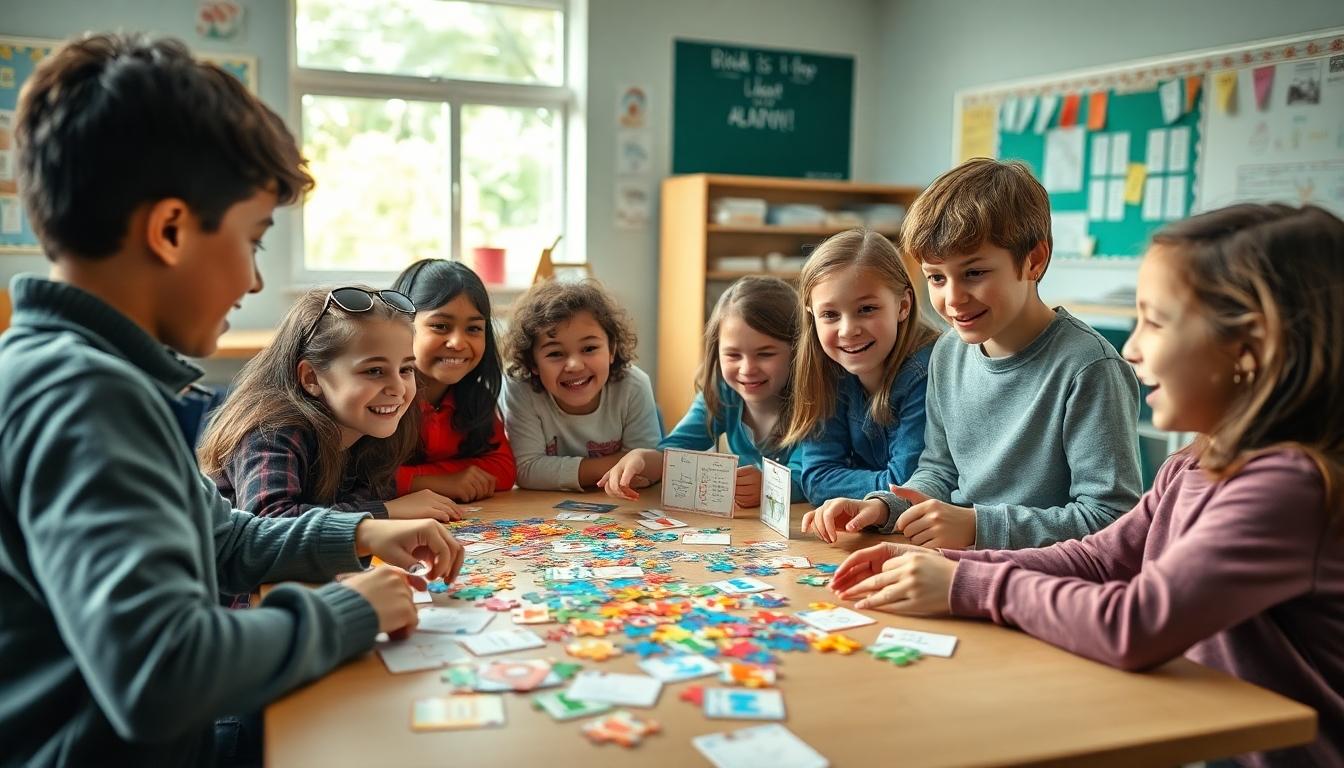
Enhances Critical Thinking & Problem-Solving
Riddles provide 5th graders with powerful opportunities to develop advanced problem-solving skills through analysis of clues and pattern identification. Students learn to break down complex problems into manageable steps when solving riddles, applying logical reasoning and deductive skills that transfer to all academic subjects. Through the process of solving riddles, children naturally develop the ability to think outside conventional boundaries, examining problems from multiple angles. These critical thinking exercises train young minds to approach challenges methodically, strengthening cognitive pathways that support academic success across math, science, and language arts.
Boosts Creativity & Language Skills
Riddles significantly expand vocabulary and linguistic flexibility as students interpret wordplay, metaphors, and words with multiple meanings. Children discover the richness of language through riddles that require understanding beyond literal interpretations, improving their comprehension abilities. Imaginative thinking flourishes when 5th graders must consider unconventional answers to verbal puzzles, strengthening their creative problem-solving approaches. Regular engagement with linguistic puzzles introduces students to nuanced expressions and helps them recognize subtle differences in word meanings, building essential language arts foundations.
Improves Concentration & Memory
The captivating nature of riddles captivates students’ attention, promoting sustained focus during challenging mental tasks. Working memory receives substantial exercise as children must hold multiple pieces of information simultaneously while working toward answers. Fifth graders show improved retention of concepts after captivating with riddles that require applying knowledge in novel contexts. Students develop greater attention spans when regularly exposed to problem-solving structures that require maintaining concentration until reaching a solution.
Strengthens Social Bonds
Collaborative riddle-solving cultivates essential teamwork and communication skills among 5th graders as they share ideas and strategies. Students learn to articulate their thinking processes clearly when explaining potential answers to peers. Shared intellectual curiosity creates positive classroom dynamics where students feel comfortable taking risks and suggesting creative answers. The collective experience of solving challenging puzzles together fosters peer connections and creates memorable learning experiences that strengthen classroom community.
Builds Math Competency
Math-exact riddles reinforce arithmetic concepts by presenting numbers and operations in captivating contextual puzzles. Students practice fractions, measurements, and mathematical reasoning through riddles that make abstract concepts concrete and approachable. Self-checking feedback mechanisms help 5th graders identify and correct errors independently, building mathematical confidence. These puzzles bridge the gap between classroom math instruction and real-industry problem-solving, helping students see the practical applications of mathematical thinking.
Key Developmental Outcomes
Cognitive flexibility develops as students adapt their thinking to ambiguous or changing parameters in different types of riddles. Resilience grows through the persistence required to solve challenging problems, teaching children to persevere through difficulties. Metacognition emerges naturally as 5th graders reflect on their problem-solving strategies, recognizing which approaches work best for different types of challenges. These foundational skills extend far beyond riddle-solving, supporting students’ overall academic development and preparing them for increasingly complex learning tasks.
Interactive Riddle Resources for Digital Learning
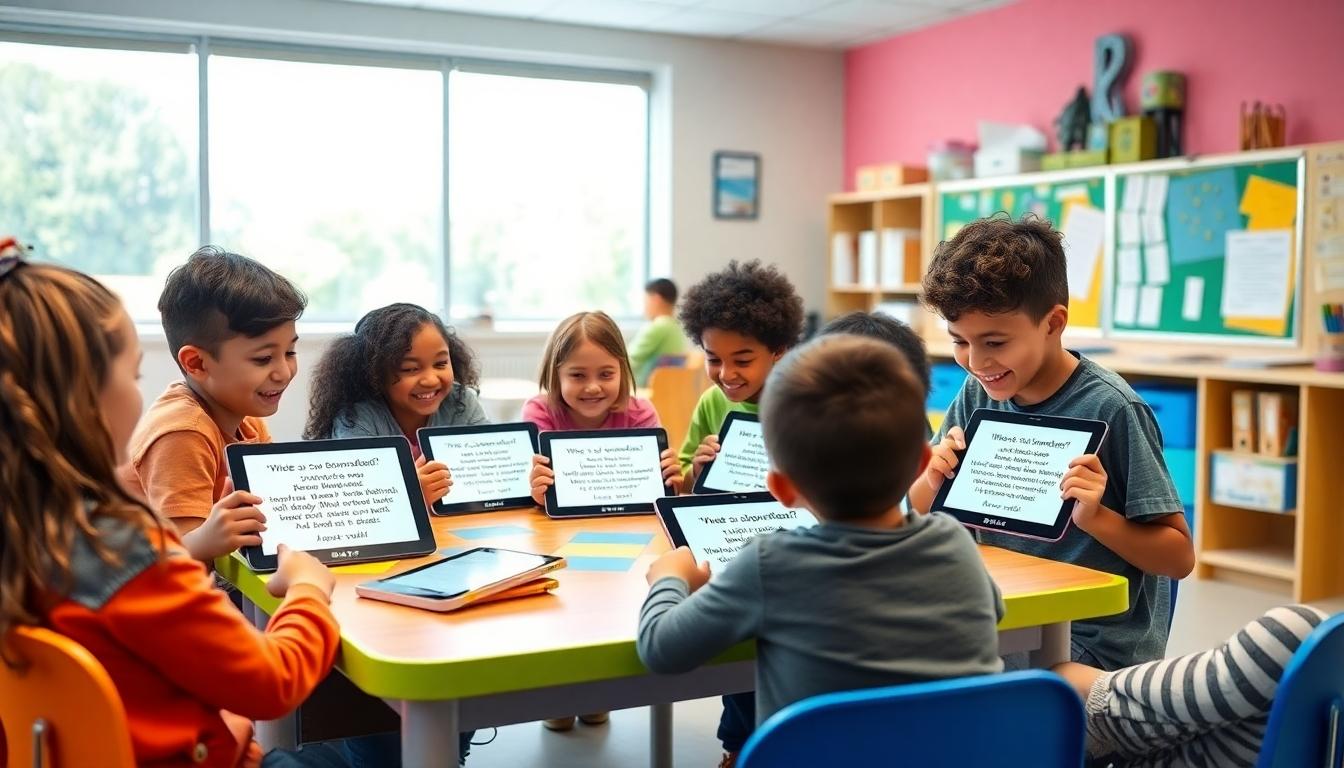
Curriculum-Aligned Digital Platforms
Educational platforms offer exceptional resources for 5th-grade riddles that align perfectly with core curriculum subjects. Teachers Pay Teachers provides structured bundles featuring 24 math riddles that cover essential concepts like fractions, measurement, and word problems. These carefully designed resources serve as excellent tools for end-of-year reviews and summer practice, reinforcing critical problem-solving skills through captivating puzzle-based learning. Students can access these materials digitally, making them ideal for both classroom and remote learning environments.
Popular Online Riddle Collections
Several interactive websites host comprehensive collections of age-appropriate riddles customized to 5th-grade cognitive levels. SplashLearn offers an impressive library of 117 riddles with answers, specifically emphasizing logical reasoning and vocabulary development. Prodigy Game presents riddles as collaborative brain exercises that encourage teamwork and discussion among students. Both platforms categorize their riddles by difficulty and subject, allowing teachers to select challenges that match exact learning objectives or student abilities.
Interactive Classroom Applications
Digital riddle resources transform traditional learning into ever-changing, captivating experiences. Websites like WeAreTeachers and BoredTeachers compile extensive lists of classroom-ready riddles perfect for group activities, icebreakers, or critical-thinking warm-ups. Popular examples include classics like “What can you catch but not throw?” (Answer: A cold) and “What has a neck but no head?” (Answer: A bottle). These digital collections enable teachers to quickly carry out riddle-based activities that captivate students’ attention while developing essential thinking skills.
Benefits of Digital Riddle Resources
Digital riddle platforms offer many advantages over traditional printed materials. Accessibility remains a key benefit, as these resources can be utilized in remote, hybrid, or traditional classroom settings without physical limitations. Many collections include answer keys for self-assessment, empowering students to check their work independently. Regular updates ensure that content stays fresh and relevant to current educational standards. Digital formats also allow for easy differentiation, enabling teachers to assign riddles based on individual student needs and learning progress.
Creating Your Own 5th Grade Riddles: Tips and Examples
Fifth-grade riddles offer much more than just entertainment. They’re powerful tools that develop critical thinking skills while bringing joy to learning. We’ve seen how these brain teasers enhance problem-solving abilities vocabulary and social interaction in classrooms and homes alike.
Integrating riddles into daily activities creates memorable learning experiences that engage students across subjects from math to language arts. Whether through printable worksheets digital platforms or classroom games riddles transform ordinary lessons into exciting challenges.
We encourage you to incorporate these mind-bending puzzles into your teaching toolkit or family activities. They’ll not only strengthen cognitive development but also create lasting memories and foster a love for learning that extends far beyond the classroom walls.
Frequently Asked Questions
Why are brain teasers good for 5th graders?
Brain teasers enhance problem-solving skills, creativity, and critical thinking in 5th graders. They serve as mental exercises that challenge young minds while remaining enjoyable and age-appropriate. These puzzles are perfect for classrooms, family game nights, and long car rides, functioning as effective ice-breakers and engaging activities that keep children both entertained and mentally stimulated.
How do math riddles benefit children’s learning?
Math riddles blend fun with learning, helping 5th graders develop critical thinking while strengthening mathematical concepts. They combine logic with arithmetic and spatial reasoning, creating connections between language and mathematics—crucial for academic success. These puzzles transform abstract math concepts into engaging challenges that improve students’ problem-solving abilities and make learning more memorable and enjoyable.
What skills do word play riddles develop?
Word play riddles enhance linguistic skills through challenges involving homophones, homonyms, and double meanings. They encourage students to explore language nuances, consider both literal and metaphorical interpretations, and expand their vocabulary. These riddles reinforce critical thinking, improve communication skills, and make language learning more memorable while creating collaborative learning environments.
How can teachers incorporate riddles into classroom activities?
Teachers can transform lessons using educational games like Riddle Relay and Riddle Bingo, or create riddle-based learning stations focusing on logic, vocabulary, collaboration, and creative writing. These stations cater to different learning styles and objectives, encouraging systematic problem-solving and creative expression. Effective implementation requires aligning riddles with lesson goals and progressively increasing difficulty as students develop their skills.
What are logic riddles and how do they help students?
Logic riddles develop problem-solving skills by enhancing analytical thinking and reasoning abilities. They include if-then puzzles that challenge students to use deductive reasoning and apply conditions to reach logical conclusions. Sequencing challenges require arranging items or events in logical order based on specific clues, fostering organizational thinking and attention to detail—essential skills for academic success.
How do science-themed riddles support education?
Science-themed riddles blend education with entertainment, sparking curiosity about the natural world while developing critical thinking. They introduce basic concepts in chemistry, environmental science, animal characteristics, and physics through fun, interactive challenges. These riddles engage 5th graders with scientific topics in an accessible way, reinforcing classroom learning and making complex concepts more approachable.
What resources are available for printable riddles?
Numerous resources offer printable riddles suitable for both home and school use, including websites like Brainzilla and ABCmouse. These collections feature classic brain teasers that encourage students to think beyond literal interpretations. Printable riddles can serve as warm-up exercises, family challenges, or classroom activities, providing convenient ways to incorporate engaging mental challenges into daily learning routines.
What are the developmental benefits of solving riddles?
Solving riddles enhances critical thinking, problem-solving skills, creativity, and language development. They improve concentration and memory by fostering sustained focus and helping students retain concepts. Collaborative riddle-solving strengthens social bonds and communication skills among peers. These activities support cognitive development, prepare students for complex learning tasks, and cultivate resilience and metacognitive skills that extend beyond the classroom.
What digital riddle resources are available for 5th graders?
Curriculum-aligned digital platforms like Teachers Pay Teachers and SplashLearn offer structured collections of age-appropriate riddles covering essential math concepts and vocabulary development. Websites like WeAreTeachers and BoredTeachers provide classroom-ready riddles for group activities. These digital resources include accessibility for remote learning, self-assessment features, and regular content updates, helping teachers differentiate instruction based on student needs.
How can parents use riddles at home?
Parents can incorporate riddles into family game nights, long car rides, or as daily brain warm-ups. They serve as excellent ice-breakers and engaging activities that keep children entertained while developing critical thinking skills. Using printable riddles or online resources, parents can create fun challenges that support their child’s cognitive development, reinforce school learning, and strengthen family bonds through collaborative problem-solving.

